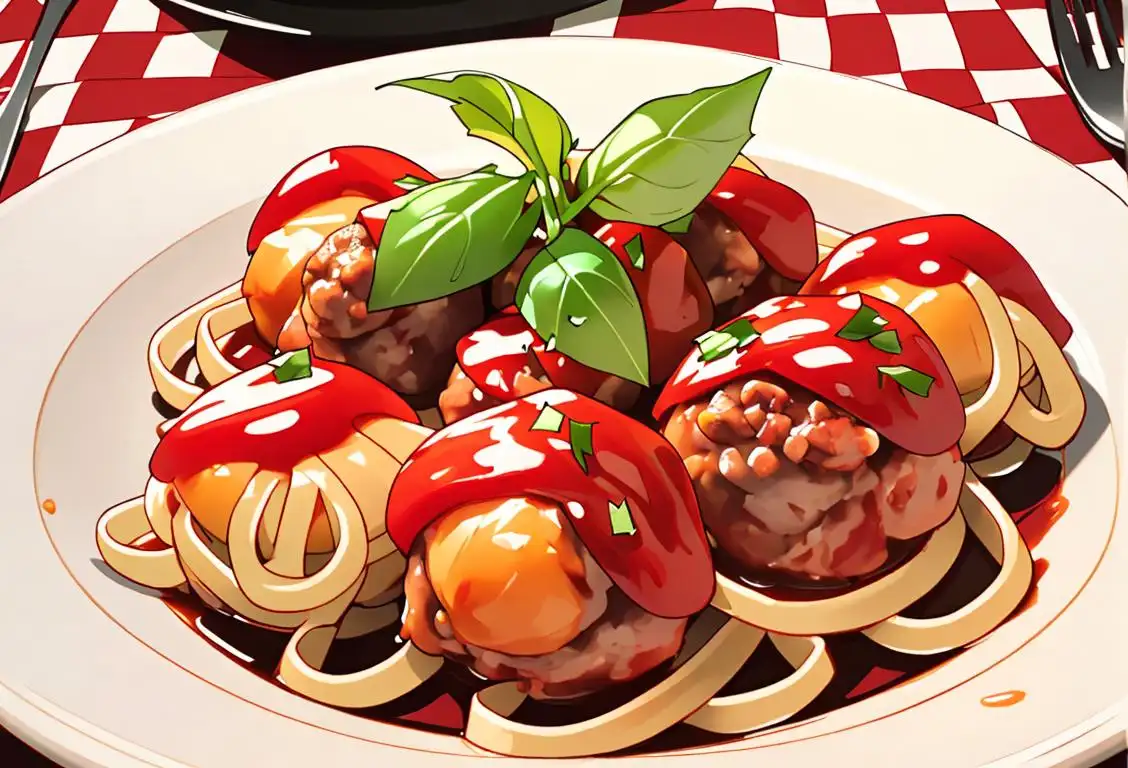National Hot Cross Buns Day

Welcome to National Hot Cross Buns Day! Get ready to indulge in these delicious, spiced buns with their iconic cross design. Whether you're a fan of their sweet and fruity flavor, or you just love the tradition that comes with them, this is the perfect day to celebrate all things hot cross buns.
When is Hot Cross Buns Day?
It's national hot cross buns day on the 11th September.
The History of Hot Cross Buns
Hot cross buns have a history as rich and varied as their ingredients. These buns are traditionally eaten on Good Friday, marking the end of Lent and the beginning of the Easter weekend. The cross on top of the buns is said to symbolize the crucifixion of Jesus, while the spices represent the spices used to embalm him.
The exact origin of hot cross buns is a bit cloudy, much like the flour used to make these delectable treats. Some say they date back to ancient Greece, where small round cakes topped with a cross were made in honor of the moon goddess Artemis. Others believe they were first created by monks in the 14th century who bestowed them to the poor on Good Friday.
Regardless of their origins, hot cross buns have become a beloved Easter tradition around the world. In fact, they're so popular that they even have their own nursery rhyme:
Hot cross buns! Hot cross buns! One a penny, two a penny, Hot cross buns!
Today, hot cross buns are enjoyed not only on Good Friday but throughout the Easter season. They can be found in bakeries, supermarkets, and even homemade in kitchens worldwide. The traditional recipe includes a dough made with flour, yeast, spices, and dried fruit such as raisins or currants. The cross on top is usually made with a mixture of flour and water or a sweet glaze.
Celebrating National Hot Cross Buns Day
Now that you know a bit about the history of hot cross buns, it's time to celebrate National Hot Cross Buns Day in style! Here are a few ideas to get you started:
- Gather your loved ones and host a hot cross bun bake-off. Who can create the most delicious batch?
- Hold a hot cross buns tasting session, sampling different varieties from bakeries or testing out unique homemade recipes.
- Organize a hot cross buns sports challenge, where participants balance buns on spoons or toss them through hoops.
- Take a moment of rememberance to reflect on the traditions and symbolism behind hot cross buns.
- Create awareness about this tasty treat by sharing hot cross bun recipes, history, and your favorite memories on social media using the hashtag #HotCrossBunsDay.
Did You Know?
In 2015, hot cross buns took the internet by storm, with a whopping 93 mentions online recorded on September 11th. It seems that hot cross buns have captured the hearts and taste buds of people all over the world!
History behind the term 'Hot Cross Buns'
79 AD
The Ancient Roots
Hot cross buns have ancient roots that can be traced back to the times of the Ancient Greeks and Romans. The Greeks would bake small honey cakes and mark them with a cross to honor the goddess Artemis. The Romans had a similar tradition, but their cross-marked cakes were devoted to the goddess Ceres. This practice of marking baked goods with a cross had strong ties to religious and spiritual beliefs of the time.
14th century
The emergence of spiced buns
In the 14th century, spiced buns began to gain popularity in England. These sweet treats were made with flour, yeast, and spices such as cinnamon, nutmeg, and allspice. The buns were often marked with a cross to symbolize the Christian faith.
1361
The Origins of Hot Cross Buns
Hot cross buns have a long history that can be traced back to the 14th century. The term 'bun' is believed to have come from the Old English word 'boun' or 'bunn', which means a small bread roll. These buns were traditionally made and eaten during certain religious festivals, particularly during Lent. The cross on top of the bun is said to represent the crucifixion of Jesus, and the spices inside the bun symbolize the spices used to embalm him.
1290 AD
The Early Mention
The earliest written reference to hot cross buns can be found in a piece of English literature called 'Poor Robin's Almanack' from 1733. However, it is believed that these buns were already popular long before that. In 1290, a monk named Brother Thomas Rocliffe, who was said to be a respected baker, marked his buns with a cross in order to honor Good Friday. This practice quickly spread throughout England.
16th century
Religious significance of hot cross buns
By the 16th century, hot cross buns had become associated with Good Friday, the Christian holiday commemorating the crucifixion of Jesus Christ. The bun's cross was seen as a symbol of the crucifixion, and it became a custom to only eat hot cross buns on Good Friday.
1592
The First Recorded Mention
The term 'hot cross bun' was first mentioned in a manuscript from 1592 titled 'Poor Robin’s Almanack'. It contained a reference to 'Good Friday bread' or 'Hot-Cross-Buns,' making it the earliest recorded mention of hot cross buns as a specific type of bun associated with Good Friday.
16th Century
Associated with Christianity
During the 16th century, hot cross buns gradually became associated with Christianity and the Easter season. The cross symbolized the crucifixion of Jesus, while the spices used in the buns represented the spices used to embalm his body. These buns were traditionally consumed on Good Friday, but their popularity continued to grow, and people started enjoying them throughout the Easter period.
1592
Regulation of hot cross buns
In 1592, Queen Elizabeth I of England issued a decree that hot cross buns could only be sold on Good Friday, Christmas, and for burials. This mandate aimed to keep the symbolic meaning of the buns intact, and it also protected the bakers' monopoly on selling them during specific times of the year.
1733
Hot Cross Buns as Street Food
By the 18th century, hot cross buns had become so popular that they were being sold as street food in the cities of London and elsewhere. Street vendors would cry out 'Hot Cross Buns!' to attract customers. This led to the popular nursery rhyme 'Hot Cross Buns,' which many children still learn and sing today.
1733 AD
Popularized in a Nursery Rhyme
The popularity of hot cross buns was further solidified when the nursery rhyme 'Hot Cross Buns' was published in 'Tommy Thumb's Pretty Song Book' in 1733. This nursery rhyme played a significant role in spreading awareness and keeping the tradition alive for generations to come. The catchy tune and repetitive lyrics helped embed the notion of hot cross buns in popular culture.
18th century
Superstitions surround hot cross buns
During the 18th century, numerous superstitions arose around hot cross buns. It was believed that buns baked on Good Friday possessed medicinal properties and could ward off illness or protect against shipwrecks if taken on voyages. Some even believed that hanging a hot cross bun in the kitchen would prevent kitchen fires.
1801
The Widely Recognized Tune
In 1801, the melody and lyrics of the popular nursery rhyme 'Hot Cross Buns' were published in 'The Gamut of Human Life' by Robert Calder. The rhyme helped to further solidify the association of hot cross buns with Good Friday and their status as a cherished Easter treat.
19th Century
Commercial Production
In the 19th century, commercial production of hot cross buns began ramping up, making them more accessible to the general public. Bakeries started offering these spiced buns year-round, although their popularity peaked during the Easter season. The aroma and distinct flavors of hot cross buns became synonymous with Easter festivities, further solidifying their place in culinary traditions.
19th century
Widespread availability of hot cross buns
With the advent of industrialization and improved transportation systems in the 19th century, hot cross buns became more widely available throughout the year. While they were still strongly associated with Good Friday, bakers began offering them as a regular treat, enabling people to enjoy them outside the confines of the prescribed dates.
19th Century
Hot Cross Buns as a Symbol of Good Luck
In the 19th century, many believed that hanging a hot cross bun in the kitchen would bring good luck for the following year. It was believed that the bun would protect the house from fire and prevent bread from going moldy. Some families even used stale hot cross buns as medicine, believing they had healing properties.
20th century
Hot cross buns in popular culture
Hot cross buns have influenced popular culture in various ways. They are mentioned in nursery rhymes, such as the famous 'Hot cross buns' song. Additionally, the phrase 'hot cross buns' is sometimes used as a metaphor for valuable objects or commodities in financial discussions, drawing on the historical association with bakers' monopolies.
20th Century
Commercial Production and Global Popularity
In the 20th century, hot cross buns became commercially produced and widely available in bakeries around the world. The combination of soft, spiced dough, raisins or currants, and the iconic cross on top made them a beloved Easter treat for many. Today, they continue to be a symbol of the Easter season and are enjoyed by people of various cultures and backgrounds.
20th Century
Variations and Worldwide Popularity
In the 20th century, hot cross buns continued to evolve and gain international popularity. Different variations of the classic recipe emerged, incorporating ingredients such as chocolate chips, dried fruit, or even savory fillings. Today, hot cross buns are enjoyed by people all over the world, not only as a traditional Easter treat but also as a delicious snack throughout the year.
Did you know?
In 2015, hot cross buns took the internet by storm, with a whopping 93 mentions online recorded on September 11th.Tagged
awareness food loved ones rememberanceFirst identified
11th September 2015Most mentioned on
11th September 2015Total mentions
93Other days
Happiness Day
Bbq Day
First Responders Day
Meatball Day
Trivia Day
Cheese Lovers Day
Biscuit Day
Pumpkin Day
Agriculture Day
Knife Day









